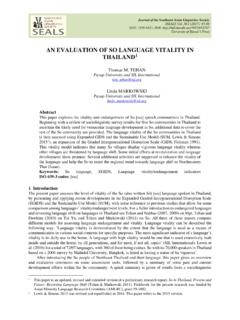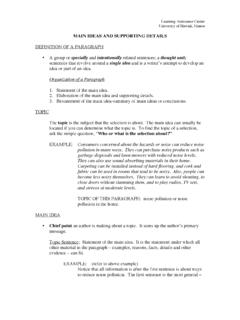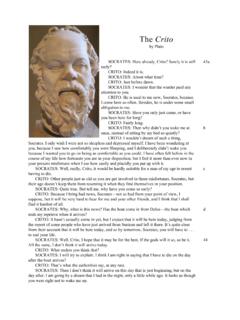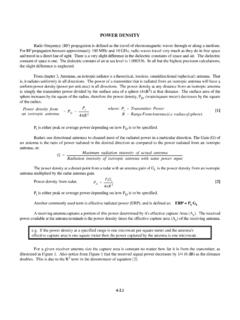Transcription of The Japanese in Hawaii: a historical and demographic ...
1 The Japanese in Hawaii: a historical and demographic perspectiveEleanor C. Nordyke and Y. Scott MatsumotoThe history of political, economic, and social changes in hawaii duringthe past century is closely interwoven with the story of the populatingof these islands by immigrants from diverse areas of the globe. Theexperience of the Japanese who arrived as indentured plantation workersdemonstrates their response to educational and economic opportunitiesand their significant contributions to the social transformation anddemographic transition of the island PERSPECTIVEThe Japanese were probably among the earliest migrants to come tothe Hawaiian Investigation of ancient landings on Oahuindicates the possibility of visits by seafarers from Japan, and a legendtells of a wrecked Japanese fishing vessel that was cast ashore at Kahalui,Maui, as early as five hundred years before the arrival of Captain JamesCook in the early nineteenth century there were several Japanesesailing vessel mishaps, and rescued seamen were brought to the most of the visitors returned to their homeland.
2 Three men fromJapan chose to remain in the islands and became naturalized as subjectsof the Kingdom of hawaii before Massive Immigration (1868-1907)3 The growth of the sugar industry as the base for the Hawaiianeconomy in the 1850s gave impetus to an increased demand for cheapEleanor C. Nordyke, , is a Community Population Specialist for the East-WestPopulation Institute, East-West Center, Honolulu. Y. Scott Matsumoto, , is Professorof Public Health, School of Public Health, University of hawaii , and Research Associate,East-West Population Institute, East-West Center, Japan was not open to Western recruitment until 1868, whenEugene Van Reed, the Hawaiian consul general in Yokohama, solicitedthe first group of 148 Japanese immigrants (140 men, six women, andtwo children).
3 4 They were called the Gannen Mono, the "First-YearPeople " because they came to hawaii in Meiji Gannen, the first yearin the reign of Emperor Meiji."First and nearest to us lies Japan, inhabited by a people generallyconsidered akin to the Hawaiians and who, we all agree, would bedesirable immigrants," said Dr. William Hillebrand, Commissioner ofthe Bureau of Immigration in the It was not long, however,before complaints were received. Japanese workers charged that theircontracts had been violated and they had received poor treatment ontheir About 40 Japanese laborers were returned to their homelandby the Hawaiian government, and the Board of Immigration redrafted atreaty on immigrant arrangements with Japan to ensure improvedtreatment for the 1872, Politician Walter Murray Gibson declared to the Chamberof Commerce of Hawaii: You have considered the races that are desirable, not only to supply your needs oflabor but to furnish an increase of population that will assimilate with the Hawaiian.
4 We must look to races, who whilst being good workers, will not much affect the identityof the Hawaiian, and whose gradual influx will harmonize with, and strengthen, by theinfusion of new blood, the native stock. A moderate portion of the Japanese , of theagricultural class, will not conflict with the view that I present, and if they bring theirwomen with them, and settle permanently in the country, they may be counted uponas likely to become desirable Hawaiian Kalakaua visited Japan for ten days in 1881 while making aglobal tour. His meeting with Emperor Meiji improved the relationshipof the Kingdom with the Japanese government, and an economicdepression in Japan served as an impetus for agricultural workers toleave their homeland. Earlier contracts which provided a wage of $4 amonth plus food, housing, and medical care were replaced with newarrangements for free steerage passage, wages per month of $9 for menand $6 for women, food allowance, lodging, medical care, fuel, no taxes,and a required savings account.
5 While only 116 Japanese were reportedas residents in the 1884 census of the Hawaiian Kingdom, the Territoryof hawaii recorded 47,508 men and 13, 603 women of the Japaneserace in '9 The laborers were selected "from the farming class with particularattention given to physical condition, youth, and industrious habits."10 They were predominantly unskilled male workers from Hiroshima andYamaguchi, two neighboring prefectures in the Chugoku district ofsouthwest Japan, and they were accustomed to rural village patterns of163early marriage, high birth rates, and large families. About 20,000 Japanese immigrants arrived from Okinawa between 1900 and 1924;they were gradually assimilated with the Japanese from Japan into thelocal growing resentment toward numbers of foreign laborers, particularlyin California, precipitated the passage of The Immigration Act of 190J,which excluded from admission into the United States "personshereinafter called contract laborers.
6 " This law provided the legalframework for an Executive Order of March 14, 1907, that stated it wasthe duty of the President to refuse entry to citizens of any foreigngovernment that issued passports for the purpose of enabling theholders to come to the United States "to the detriment of labor conditionstherein."11 This was followed by the Gentlemen's Agreement of igo8whereby the Japanese Government cooperated with the United Statesand imposed restrictions upon the departure of Japanese emigrants forthe United States. The issuance of passports to hawaii was limited to"former residents" and "parents, wives, and children of residents."Congress closed the door on further immigraton by passing the Immigra-tion Quota Law of May 26, 1924, also known as the " Japanese ExclusionAct.
7 " This law declared that aliens ineligible for citizenship (only whiteand black aliens were eligible) were excluded from permanent immigra-tion, and it governed immigration policy until Period of Family Formation (igo8-ig2o)The period from 1908 to 1920 is commonly called the Yobiyose Jidai,the "period of summoning" of brides and families. Unlike the Chineseand Caucasian immigrant workers who intermarried with Hawaiian andPortuguese women, Japanese males seldom intermarried because of theavailability of Japanese women as "picture brides" (young women whowere married by proxy in Japan to men whom they had never met orwho married after meeting their intended husbands upon arrival in theTerritory of hawaii ). Between 1911 and 1919 there were 9,841 picturebrides admitted at the port of Honolulu, and in 1920, there were moreJapanese men who were married than men of any other ethnic groupin from Japan between 1868 and 1924 totaled 159,288 men,49,612 women, and 4,852 children.
8 Disenchanted with work on theplantations, many Japanese moved away after the expiration of theircontracts. Sociologist Andrew Lind estimates that 40,000 persons leftHawaii for the continental United States, and many returned to , the majority of the Japanese population remained in the164 Japanese immigrant plantation workers in hawaii in 1890. J. T. Phillips Collection State Madrigal Choir Director Shigeru Hotoke is greeted at the Capitolin Washington, in 1974 by United States Representative SparkyM. Matsunaga, Patsy Takemoto Mink, and Senator Daniel K. of Patsy T. Minkislands, sought improvement in their working and living conditions, andpromoted educational achievement for their count of the Japanese population in hawaii increased from 79,675in 1910 to 109,274 in 1920, when it constituted percent of the totalpopulation (Table 1).
9 The relatively high crude birth rate among theJapanese ( per thousand in 1920) was related to the large percentageTABLE 1. THE Japanese POPULATION IN HAWAIIYear1872: : : : June1910: : : : : : : 56,897116 80,57812,610 89,99061,111 154,00179,675 191,874109,274 255, 368, 422,770184,598 499,794203,455 632,772217,669 769,913 PopulationPercentageJapanese AnnualGrowth RatebJapanese = Not "Total" includes all persons residing in the Kingdom, Territory, or State of Computed by the formula r = 100 loge (P2/Pi) : Schmitt, 1968, Table 1.
10 Gardner and Nordyke, 1974, Table and to the age and sex composition of their population ( of the Japanese population were between the ages of 20 and 45).Population increase was also associated with the reduction of deathsbrought about by improved health, better nutrition, and reduced maternaland infant Issei (first generation immigrants from Japan) and Nisei(children of Issei) moved to Honolulu and other developing urbancenters. The alien land laws encouraged urbanization since non-citizenscould not own land. Isseis became independent wage earners, merchants,shopkeepers, and tradesmen. They sought and began to achieve Maturation of the Nisei ( )The children of Issei immigrants born in hawaii were Americancitizens by birth. American law required schooling for children, and165education was encouraged by Japanese families.











